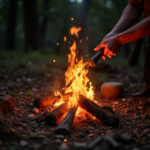When you’re out in the wild and things go sideways, it’s the little tools in your pack that can make all the difference. A signaling mirror is one of those lifesavers. It’s small, simple, and powerful enough to catch the attention of rescuers from miles away—sometimes even up to 10 miles on a sunny day! Whether you’re hiking, camping, or just prepping for emergencies, knowing how to use this tool can help you get rescued faster. Let’s walk through some easy tips to make sure you’re ready if the need arises.
Why a Signaling Mirror Matters
Think of a signaling mirror as a flashlight powered by the sun. It reflects sunlight into a bright, visible flash that you can aim toward someone far away—like a plane, a boat, or a rescue team. Unlike batteries that might die or flares that burn out, a signaling mirror works as long as there’s light. That’s why it’s a must-have for anyone venturing outdoors.
Getting Started with Your Mirror
Step 1: Check Your Mirror
First things first: make sure your signaling mirror is in good shape before you head out. Most survival mirrors are compact and sturdy, but it’s always a good idea to give it a quick check for cracks or dirt. If your mirror has a sighting hole (that little hole in the middle), it’ll make aiming easier, but even a basic mirror will do the job.
Step 2: Find the Sun
To use a signaling mirror, you’ll need some sunlight. Find a spot where the sun hits directly, like a clear area away from trees or shadows. If you’re dealing with clouds, don’t give up! Even a little sunlight can produce enough reflection to work.
Step 3: Aim the Beam
Hold the mirror close to your face and tilt it toward the sun. You’ll notice a bright light reflecting off the surface. Use your hand or another surface to “catch” the light, and then angle it so the beam points toward your target. If your mirror has a sighting hole, look through it while aiming to make it even easier to stay on target.
Pro Tips for Success
Keep Flashing
Once you’ve got your beam aimed, flash it repeatedly in the same direction. A steady, repetitive signal is easier for rescuers to notice than a single quick flash. Think of it like waving your arms—it’s all about getting attention!
Cover More Ground
If you’re not sure where help is coming from, sweep the mirror in slow, wide arcs to cover more area. This way, whether a plane is passing overhead or a boat is nearby, they’re more likely to see your signal.
Team Up with Other Signals
A signaling mirror works even better when paired with other rescue tools. Blow a whistle, wave a brightly colored cloth, or build a signal fire to increase your chances of being seen or heard.
Practice Makes Perfect
Like any skill, using a signaling mirror gets easier the more you practice. Take your mirror outside on a sunny day and try aiming it at distant objects like trees or buildings. Get comfortable finding that bright reflection and directing it to where you want it to go. You’ll feel much more confident if you ever need to use it for real.
Picking the Right Mirror
Not all mirrors are the same, so it’s worth investing in one made for survival situations. Look for a lightweight, durable model that’s easy to pack. Some even come with built-in sighting tools, which can make aiming a breeze. Store it in a waterproof case to keep it clean and ready for action.
A signaling mirror might seem like a simple tool, but in an emergency, it’s a real game-changer. With just a little sunlight and some know-how, you can send a signal that gets noticed, whether you’re lost in the mountains or stranded at sea. Take a few minutes to practice and keep your mirror handy—it’s a small item that could save your life one day.
Also see: Lost? Find Civilization Fast



